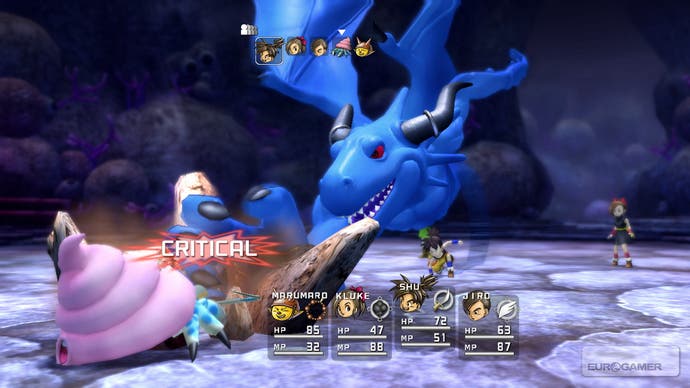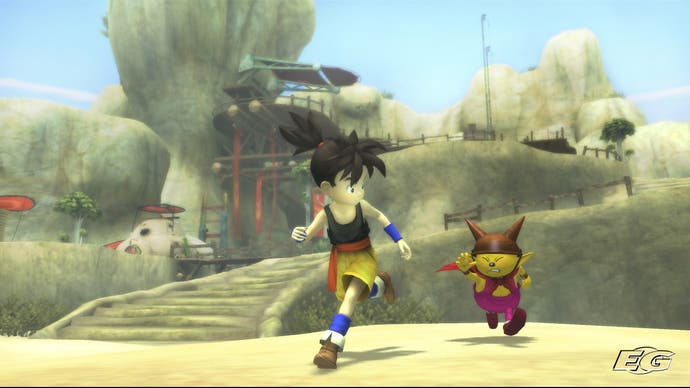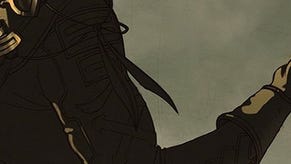Blue Dragon
Definitely feeling blue.
It's extraordinarily difficult to approach Blue Dragon without some kind of baggage in tow.
There are two key reasons for this; firstly, this game has been hyped by its publisher, Microsoft, as the first Great White Hope (great blue hope, perhaps?) for Japanese style games on the Xbox 360. Even before it appeared in Japan, long before anyone without a working knowledge of kanji could get their chops around it, it was being hailed by fanboys as evidence that the Xbox 360 could win over even the notoriously suspicious Japanese developers who had all but ignored the previous Xbox.
Secondly, the first three names to appear in Blue Dragon's understated credits sequence when you start a new game are all legends in the world of Japanese RPGs. Hironobu Sakaguchi, whose Mist Walker studio is responsible for the design of the game, is the creator of the Final Fantasy series. Nobuo Uematsu composed all the music for Final Fantasy until the most recent games. Akira Toriyama, meanwhile, is the character designer behind the massive Dragon Quest franchise, and Square's cult classic Chrono Trigger.

It's a game which comes loaded with expectations, then. On the one hand, it faces being encumbered with vastly more significance than any game would ever want, thanks to being on the vanguard of the Console War which is claiming casualties among fanboys, loudmouths and idiots in the grim trenches of forums all over the Internet. On the other hand, its famous development team inspire great hopes for the game.
Having mentioned all the baggage, let's try now to leave it all sitting in the hallway. Regardless of expectations, the second you press Start on the title screen, Blue Dragon is just another game. No matter what nonsense "significance" it may be imbued with by platform fanboys, it lives or dies on whether or not it is entertaining, enjoyable, gripping and compelling. Drop the bags. Let's go play.
Pure and Simple
The game kicks off in relatively dramatic fashion, with ominous purple clouds gathering over a village in a rocky desert area. The villagers, who are used to these clouds as an omen of impending destruction, flee to higher ground; sure enough, the village is promptly attacked by a "Land Shark", whose fin is just visible above the ground.
Playing an old man, the grandfather of the main protagonist, Shu, you walk around the various villagers and learn that these attacks have been happening on an annual basis for ten years. You also learn, however, that Shu isn't among the villagers on higher ground. As it transpires, the impulsive Shu and his rather geeky friend, Jiro, have hatched a plan to trap the Land Shark and remained down at ground level.
The two boys are joined by a third playable character, Kluke, a girl whose parents were killed in a previous Land Shark attack. In a largely non-interactive sequence (you sometimes have control, but only to run around briefly and to engage in a single, pre-determined battle), they trap the Land Shark, and are then dragged off by the Shark and into a distant chasm full of ancient ruins.

The story evolves from this point pretty much along classic J-RPG lines. The backwards world in which the main characters live is built over the top of buried ruins of an advanced technological society. The Land Shark is actually a machine, which sheds its disguise and carries the trio up to a giant airship that lurks in the middle of the purple clouds. An evil old man, Nene, lives on this airship guarded by robots, and the three heroes escape from him only by imbibing the power of strange light spheres which grant them magical powers.
The story, in other words, is much more traditional and simple than we've come to expect from more recent RPG titles - and the characters, too, fit into a set of relatively simple archetypes. They all appear to be in their early teens, and you've got the impulsive, determined Shu (whose catchphrase is "I won't give up" - hmm), the bookish, clever Jiro, the headstrong but feminine Kluke... There's even a chaste pre-pubescent romance brewing between Jiro and Kluke. Aww.
Even the villain is on traditional fictional ground - he's largely speaking evil because he likes being evil. Although Microsoft's strange restrictions on what we're allowed to talk about in our previews (anything after a relatively early point in the game is off-limits, apparently) won't let us tell you what his motivations are, suffice it to say that you're unlikely to bat an eyelid.
Now, this might not sound like the most positive basis for a lengthy RPG - and for some players, we're quite certain that it's going to be offputting. Others, however, may well love Blue Dragon's approach, which feels like nothing quite so much as an old Saturday morning cartoon. Given that, it's perhaps no surprise that Blue Dragon has indeed been turned into a children's cartoon in Japan. It may be simple, but simplicity often has charm of its own.
Plastic World

It's not just the story and characters which echo this kind of Saturday morning cartoon simplicity. The graphics, too, focus heavily on strong, clean lines, flat shading and bright primary colours. Akira Toriyama's human character designs are often criticised for lacking in variety, and Blue Dragon will do little to answer such criticism; the central characters and villains are all incredibly similar to the designs Toriyama has used previously in Dragon Quest and in the likes of Dragonball Z.
Jiro has a side parting; that's how you know he's geeky. Nene is old, bald, has pointy ears and purple skin; that's how you know he's evil. Again, however, it's quite possible to categorise this as a homage to a simpler age of storytelling - and one could argue that Toriyama more than compensates for the human designs with some superbly creative creature designs, which look like they've come straight from the copybook of a particularly gifted (or disturbed) ten year old.
Strangely, however, the power of the Xbox 360 is actually used to good effect in Blue Dragon - despite the simplicity of the artwork. Every character, monster and environment is rendered with extremely detailed lighting and bump mapping, and the game uses exaggerated depth of field (much like the focusing of a camera lens) which makes everything feel almost disconcertingly real in places. The overall effect is not dissimilar to Pixar's Toy Story, in fact; the whole world feels like it's made out of animated plastic models. In places, this effect is genuinely stunning - about as far from photo-realism as you can get, and yet spookily real in its own, stylised way.




.png?width=291&height=164&fit=crop&quality=80&format=jpg&auto=webp)




.jpg?width=291&height=164&fit=crop&quality=80&format=jpg&auto=webp)
